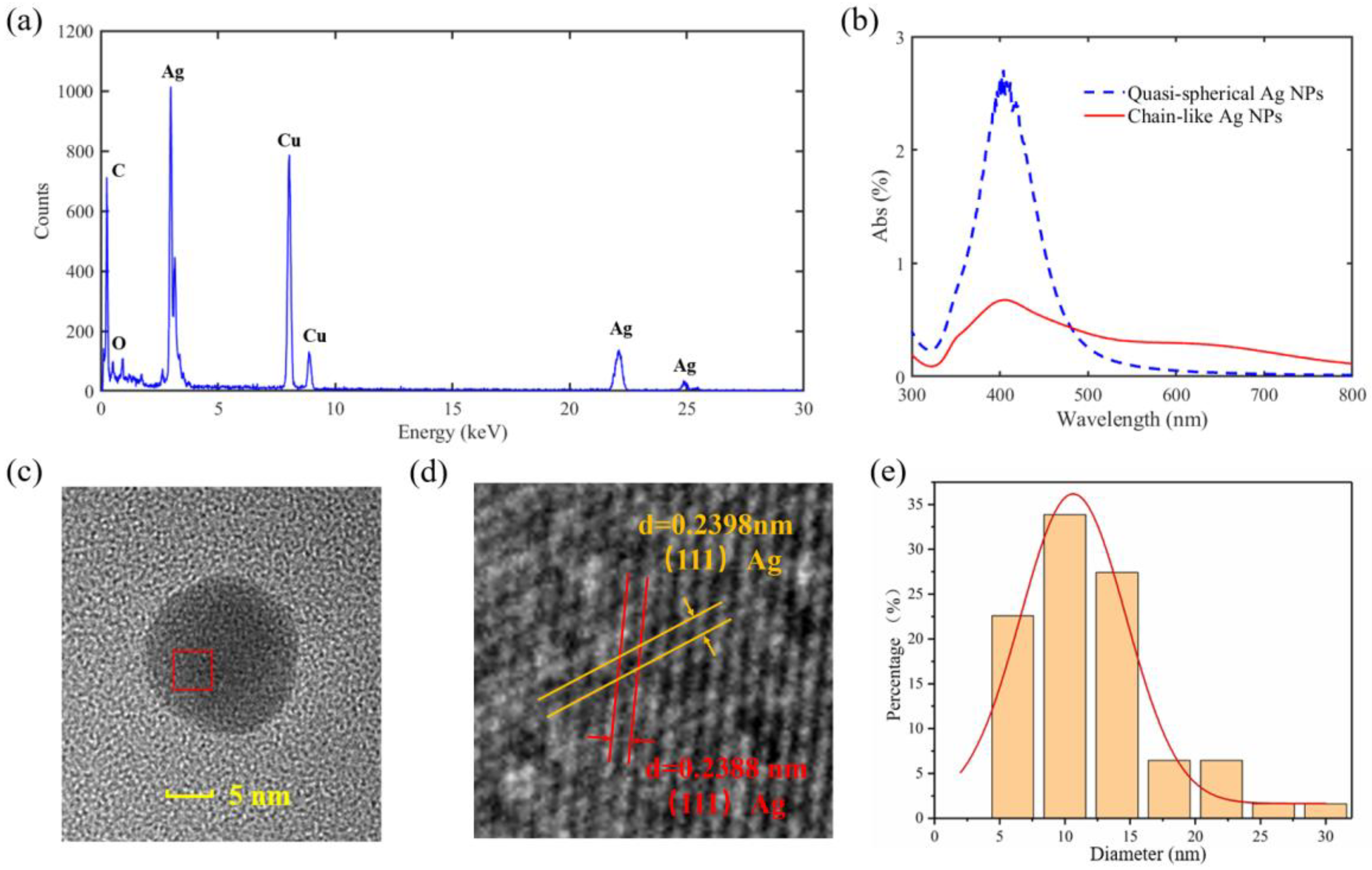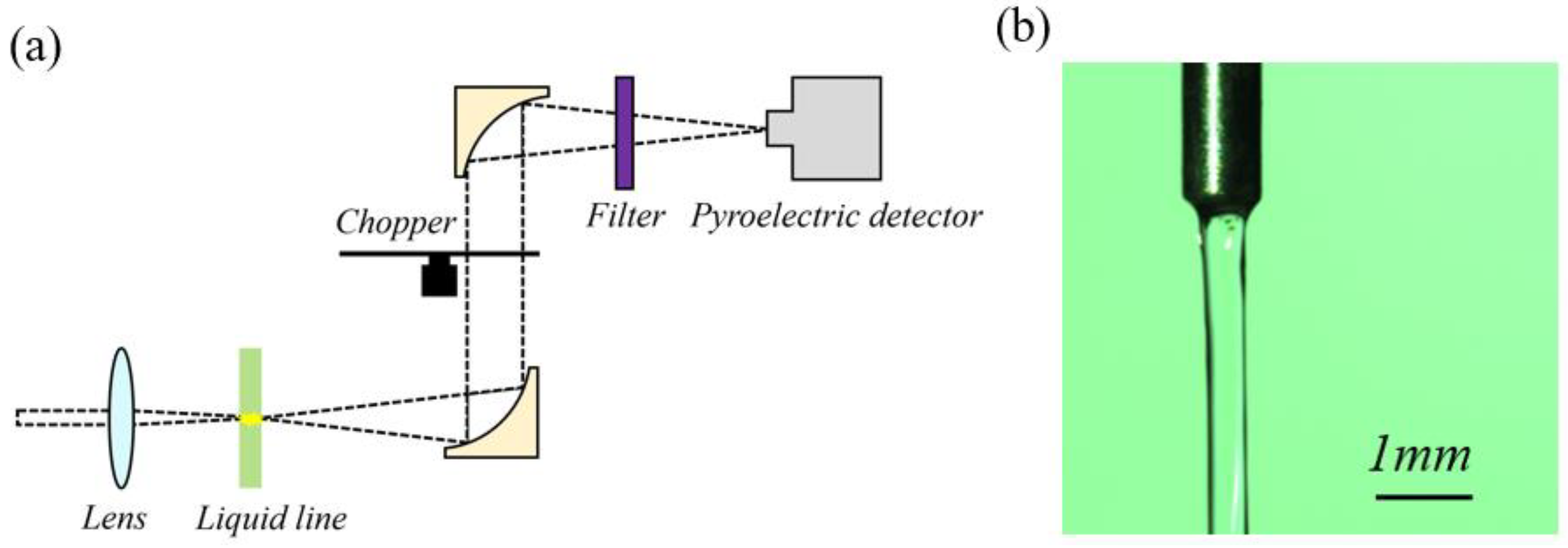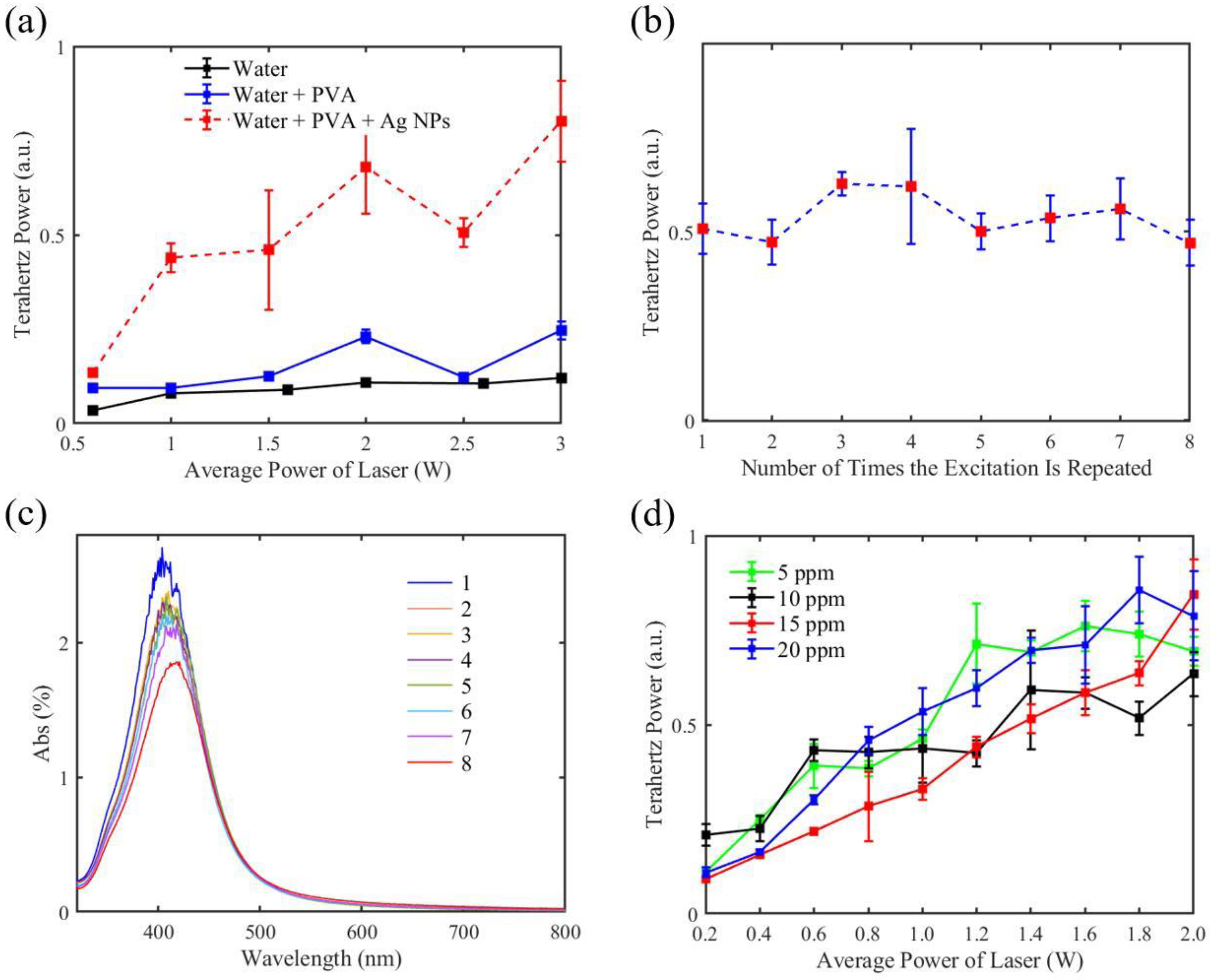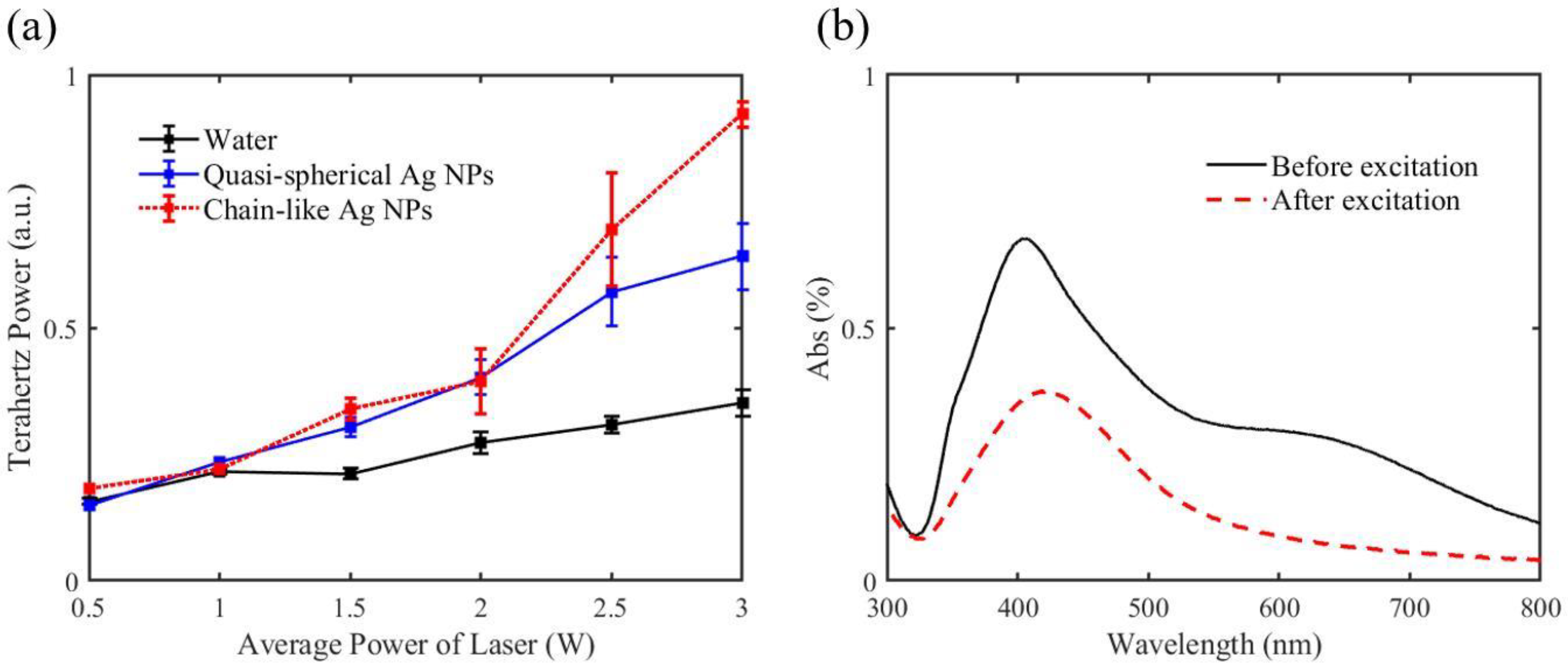Enhancement of Terahertz Emission by Silver Nanoparticles in a Liquid Medium
Abstract
:1. Introduction
2. Materials and Methods
2.1. The Synthesis of Ag NP Suspensions
2.2. Characterizations of Ag NP Suspensions
2.3. Experimental Setup
3. Results
3.1. Quasispherical Ag NPs
3.2. Chain-Like Ag NPs
4. Discussion
5. Conclusions
Author Contributions
Funding
Data Availability Statement
Acknowledgments
Conflicts of Interest
References
- Andreeva, V.A.; Kosareva, O.G.; Panov, N.A.; Shipilo, D.E.; Solyankin, P.M.; Esaulkov, M.N.; González de Alaiza Martínez, P.; Shkurinov, A.P.; Makarov, V.A.; Bergé, L.; et al. Ultrabroad Terahertz Spectrum Generation from an Air-Based Filament Plasma. Phys. Rev. Lett. 2016, 116, 063902. [Google Scholar] [CrossRef] [PubMed] [Green Version]
- Zhang, Y.; Sun, W.; Wang, X.; Ye, J.; Feng, S.; Han, P.; Zhang, Y. Active stabilization of terahertz waveforms radiated from a two-color air plasma. Opt. Lett. 2017, 42, 1907–1910. [Google Scholar] [CrossRef] [PubMed]
- Buccheri, F.; Zhang, X.C. Terahertz emission from laser-induced microplasma in ambient air. Optica 2015, 2, 366–369. [Google Scholar] [CrossRef] [Green Version]
- Ma, D.; Dong, L.; Zhang, M.; Wu, T.; Zhao, Y.; Zhang, L.; Zhang, C. Enhancement of terahertz waves from two-color laser-field induced air plasma excited using a third-color femtosecond laser. Opt. Express 2020, 28, 20598–20608. [Google Scholar] [CrossRef] [PubMed]
- Ma, D.; Dong, L.; Zhang, R.; Zhang, C.; Zhao, Y.; Zhang, L. Enhancement of terahertz wave emission from air plasma excited by harmonic three-color laser fields. Opt. Commun. 2021, 481, 126533. [Google Scholar] [CrossRef]
- Jin, Q.; Yiwen, E.; Zhang, X.C. Terahertz aqueous photonics. Front. Optoelectron. 2021, 14, 37–63. [Google Scholar] [CrossRef] [PubMed]
- Ponomareva, E.A.; Stumpf, S.A.; Tcypkin, A.N.; Kozlov, S.A. Impact of laser-ionized liquid nonlinear characteristics on the efficiency of terahertz wave generation. Opt. Lett. 2019, 44, 5485–5488. [Google Scholar] [CrossRef] [PubMed]
- Chen, Y.; He, Y.; Tian, Z.; Dai, J. Lateral terahertz wave emission from laser induced plasma in liquid water line. Appl. Phys. Lett. 2022, 120, 041101. [Google Scholar] [CrossRef]
- Zhang, L.L.; Wang, W.M.; Wu, T.; Feng, S.J.; Kang, K.; Zhang, C.L.; Zhang, X.C. Strong Terahertz Radiation from a Liquid-Water Line. Phys. Rev. Appl. 2019, 12, 014005. [Google Scholar] [CrossRef] [Green Version]
- Chen, Y.; He, Y.; Zhang, Y.; Tian, Z.; Dai, J. Systematic investigation of terahertz wave generation from liquid water lines. Opt. Express 2021, 29, 20477–20486. [Google Scholar] [CrossRef]
- Dey, I.; Jana, K.; Fedorov, V.Y.; Koulouklidis, A.D.; Mondal, A.; Shaikh, M.; Kumar, G.R. Highly efficient broadband terahertz generation from ultrashort laser filamentation in liquids. Nat. Commun. 2017, 8, 1184. [Google Scholar] [CrossRef] [PubMed] [Green Version]
- Jin, Q.; Yiwen, E.; Williams, K.; Dai, J.; Zhang, X.C. Observation of broadband terahertz wave generation from liquid water. Appl. Phys. Lett. 2017, 111, 071103. [Google Scholar] [CrossRef]
- Jin, Q.; Dai, J.; Zhang, X.C. Terahertz wave emission from a liquid water film under the excitation of asymmetric optical fields. Appl. Phys. Lett. 2018, 113, 261101. [Google Scholar] [CrossRef] [Green Version]
- Ponomareva, E.A.; Tcypkin, A.N.; Smirnov, S.V.; Putilin, S.E.; Yiwen, E.; Kozlov, S.A.; Zhang, X.C. Double-pump technique—One step closer towards efficient liquid-based THz sources. Opt. Express 2019, 27, 32855–32862. [Google Scholar] [CrossRef] [PubMed] [Green Version]
- Jin, Q.; Zhang, X.C. Enhancement of terahertz emission by a preformed plasma in liquid water. Appl. Phys. Lett. 2019, 115, 101101. [Google Scholar]
- Sarpe, C.; Köhler, J.; Winkler, T.; Wollenhaupt, M.; Baumert, T. Real-time observation of transient electron density in water irradiated with tailored femtosecond laser pulses. New J. Phys. 2012, 14, 075021. [Google Scholar] [CrossRef] [Green Version]
- Kim, K.Y.; Glownia, J.H.; Taylor, A.J.; Rodriguez, G. Terahertz emission from ultrafast ionizing air in symmetry-broken laser fields. Opt. Express 2007, 15, 4577–4584. [Google Scholar] [CrossRef]
- Wang, H.Y.; Shen, T. Unified theoretical model for both one- and two-color laser excitation of terahertz waves from a liquid. Appl. Phys. Lett. 2020, 117, 131101. [Google Scholar] [CrossRef]
- Ismagilov, A.O.; Ponomareva, E.A.; Zhukova, M.O.; Putilin, S.E.; Nasedkin, B.A.; Tcypkin, A.N. Liquid jet-based broadband terahertz radiation source. Opt. Eng. 2021, 60, 082009. [Google Scholar] [CrossRef]
- Tcypkin, A.N.; Ponomareva, E.A.; Putilin, S.E.; Smirnov, S.V.; Shtumpf, S.A.; Melnik, M.V.; E, Y.; Kozlov, S.A.; Zhang, X.C. Flat liquid jet as a highly efficient source of terahertz radiation. Opt. Express 2019, 27, 15485–15494. [Google Scholar] [CrossRef] [Green Version]
- Cao, Y.; Ling, F.; Zhang, X.C. Flowing cryogenic liquid target for terahertz wave generation. AIP Adv. 2020, 10, 105119. [Google Scholar]
- Balakin, A.V.; Coutaz, J.L.; Makarov, V.A.; Kotelnikov, I.A.; Peng, Y.; Solyankin, P.M.; Zhu, Y.; Shkurinov, A.P. Terahertz Wave Generation from Liquid Nitrogen. Photonics Res. 2019, 7, 678–686. [Google Scholar] [CrossRef]
- Chen, Y.; He, Y.; Liu, L.; Tian, Z.; Dai, J. Scaling of the terahertz emission from liquid water lines by plasma reshaping. Opt. Lett. 2022, 47, 5969–5972. [Google Scholar] [CrossRef] [PubMed]
- E, Y.; Zhang, L.; Tcypkin, A.; Kozlov, S.; Zhang, C.; Zhang, X.-C. Broadband THz Sources from Gases to Liquids. Ultrafast Sci. 2021, 2021, 9892763. [Google Scholar] [CrossRef]
- E, Y.; Zhang, L.; Tcypkin, A.; Kozlov, S.; Zhang, C.; Zhang, X.-C. Progress, challenges, and opportunities of terahertz emission from liquids. J. Opt. Soc. Am. B 2022, 39, A43–A51. [Google Scholar] [CrossRef]
- Cao, Y.; Huang, P.; Zhang, X.C. Broadband terahertz wave emission from liquid metal. Appl. Phys. Lett. 2020, 117, 041107. [Google Scholar] [CrossRef]
- Leemans, W.P.; Geddes, C.G.R.; Faure, J.; Tóth, C.; van Tilborg, J.; Schroeder, C.B.; Esarey, E.; Fubiani, G.; Auerbach, D.; Marcelis, B.; et al. Observation of terahertz emission from a laser-plasma accelerated electron bunch crossing a plasma-vacuum boundary. Phys. Rev. Lett. 2003, 91, 074802. [Google Scholar] [CrossRef] [PubMed] [Green Version]
- Liao, G.; Li, Y.; Zhang, Y.; Liu, H.; Ge, X.; Yang, S.; Wei, W.; Yuan, X.; Deng, Y.; Zhu, B.; et al. Demonstration of coherent terahertz transition radiation from relativistic laser-solid interactions. Phys. Rev. Lett. 2016, 116, 205003. [Google Scholar] [CrossRef] [Green Version]
- Solyankin, P.M.; Lakatosh, B.V.; Krivokorytov, M.S.; Tsygvintsev, I.P.; Sinko, A.S.; Kotelnikov, I.A.; Shkurinov, A.P. Single Free-Falling Droplet of Liquid Metal as a Source of Directional Terahertz Radiation. Phys. Rev. Appl. 2020, 14, 034033. [Google Scholar] [CrossRef]
- Durán, N.; Durán, M.; De Jesus, M.B.; Seabra, A.B.; Fávaro, W.J.; Nakazato, G. Silver nanoparticles: A new view on mechanistic aspects on antimicrobial activity. Nanomed. Nanotechnol. Biol. Med. 2016, 12, 789–799. [Google Scholar]
- Prabhu, S.; Poulose, E.K. Silver nanoparticles: Mechanism of antimicrobial action, synthesis, medical applications, and toxicity effects. Int. Nano Lett. 2012, 2, 32. [Google Scholar] [CrossRef] [Green Version]
- Abdul Kareem, T.; Anu Kaliani, A. Synthesis and thermal study of octahedral silver nano-plates in polyvinyl alcohol (PVA). Arab. J. Chem. 2011, 4, 325–331. [Google Scholar] [CrossRef] [Green Version]
- Kyrychenko, A.; Pasko, D.A.; Kalugin, O.N. Poly (vinyl alcohol) as a water protecting agent for silver nanoparticles: The role of polymer size and structure. Phys. Chem. Chem. Phys. 2017, 19, 8742–8756. [Google Scholar] [PubMed]
- Navaladian, S.; Viswanathan, B.; Viswanath, R.P.; Varadarajan, T.K. Thermal decomposition as route for silver nanoparticles. Nanoscale Res. Lett. 2006, 2, 44–48. [Google Scholar] [CrossRef] [PubMed] [Green Version]
- Azad, A.K.; Dai, J.; Zhang, W. Transmission properties of terahertz pulses through subwavelength double split-ring resonators. Opt. Lett. 2006, 31, 634–636. [Google Scholar] [CrossRef] [PubMed]
- Hu, J.; Yang, L.; Zhu, Y.; Yang, D.Q.; Sacher, E. Destabilization of PVA-stabilized Ag NPs color changes at low aqueous concentrations induced by aggregation and coalescence. Mater. Res. Express 2020, 7, 025003. [Google Scholar] [CrossRef]
- Zhang, X.-C.; Buccheri, F. Terahertz Photonics of Microplasma and beyond. Lith. J. Phys. 2018, 58, 1–14. [Google Scholar] [CrossRef] [Green Version]
- Kim, K.Y.; Glownia, J.H.; Taylor, A.J.; Rodriguez, G. High-Power Broadband Terahertz Generation via Two-Color Photoionization in Gases. IEEE J. Quantum Electron. 2012, 48, 797–805. [Google Scholar] [CrossRef]
- Ageev, I.M.; Rybin, Y.M. Features of Measuring the Electrical Conductivity of Distilled Water in Contact with Air. Meas. Tech. 2020, 62, 923–927. [Google Scholar] [CrossRef]
- Bardeen, J. Electrical conductivity of metals. J. Appl. Phys. 1940, 11, 88–111. [Google Scholar] [CrossRef]








Disclaimer/Publisher’s Note: The statements, opinions and data contained in all publications are solely those of the individual author(s) and contributor(s) and not of MDPI and/or the editor(s). MDPI and/or the editor(s) disclaim responsibility for any injury to people or property resulting from any ideas, methods, instructions or products referred to in the content. |
© 2023 by the authors. Licensee MDPI, Basel, Switzerland. This article is an open access article distributed under the terms and conditions of the Creative Commons Attribution (CC BY) license (https://creativecommons.org/licenses/by/4.0/).
Share and Cite
Wang, H.; Shen, T.; Liu, J.; Zhu, Y.; Li, H.; Wang, T. Enhancement of Terahertz Emission by Silver Nanoparticles in a Liquid Medium. Micromachines 2023, 14, 1593. https://doi.org/10.3390/mi14081593
Wang H, Shen T, Liu J, Zhu Y, Li H, Wang T. Enhancement of Terahertz Emission by Silver Nanoparticles in a Liquid Medium. Micromachines. 2023; 14(8):1593. https://doi.org/10.3390/mi14081593
Chicago/Turabian StyleWang, Haoyang, Tao Shen, Jinkun Liu, Yan Zhu, Hong Li, and Tianwu Wang. 2023. "Enhancement of Terahertz Emission by Silver Nanoparticles in a Liquid Medium" Micromachines 14, no. 8: 1593. https://doi.org/10.3390/mi14081593




